How to Grow Hydrangea Bushes
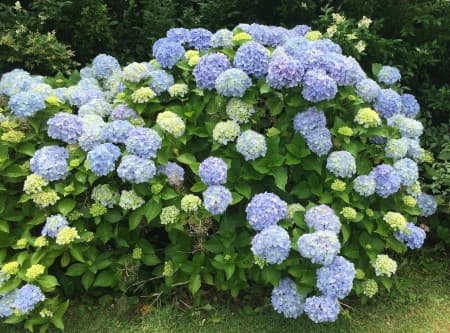
About Growing Hydrangea Flowers in Your Home Garden
Hydrangea bushes are beautiful, perennial bushes with huge flower heads. These deciduous bushes profusely produce huge, round flower heads in mid-summer. Hydrangea plants are native to North and South America, the Himalayas, and central and eastern Asia. And, if you have deer munching on the flowers in your yard, you’re going to love this beautiful bush. The deer leave it alone. Learn how to grow hydrangea flowers with this plant guide.
Colors include white, pink, blue lilac, purple, varying shades of these colors, and a variety of two tones.
Flower heads have two kinds of florets Sterile, or ray florets, are male and form the large, colorful sepals on the outside of the flower head. The fertile florets bear the male and female parts and are usually found in the center of the cluster.
During the spring through fall, these bushes have attractive foliage. Most varieties of Hydrangea grow from 3 to over 10 ft. tall. Some varieties grow up to 25 feet. Most varieties prefer full sun to partial shade.
Perhaps the only downside to these lush plants with their colorful blooms, is that they shed their leaves in the fall. The leafless bush transforms into a less-than-attractive clump of stalks and stems until the following spring.
Did you know? There are over 1200 species of Hydrangeas. People just can’t get enough of these beautiful blooms.
Hydrangea Flowers Plant Specifications
Flower Colors: Blue, green, pink, purple, red, and white
Flowers Bloom: Mid-Summer to Fall.
Plant height: This attractive shrub grows up to 10 feet tall and 10 feet wide.
Light Requirements: Full sun to partial sun.
Ideal Soil pH: 4.0 – 8.0. Soil pH influences flower colors.
Toxic?: Yes. The shrub is toxic to people and pets.
Deer Resistant?: No. Deer eat the foliage.
Hardiness Zones: 5 – 9
Plant Type: Pernnial shrub
Native To: Asia, Japan, and the Americas.
Botanical Name: Hydrangea hortensia
Number of Species: Over 1,200.
Other Names: There are a variety of names. They all end with the word “Hydrangea”.
Are Hydrangea Flower Plants Edible?
No!!‘
This plant is toxic to children and pets. It contains cyanogenic glycosides. Stomach acids turn this chemical into cyanide. If eaten in significant amounts, it can cause stomach distress or worse.
Oddly, deer will eat the leaves of the plant. But, apparently not in sufficient quantities to cause them problems.
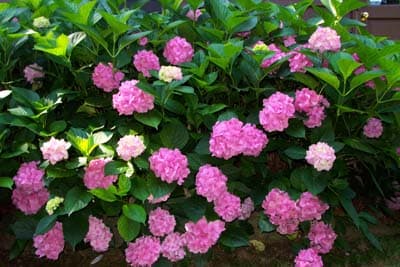
Medicinal Uses for Hydrangea Shrubs
The root and underground stems are used for a variety of medicinal applications. Here are some of them:
- Use it to treat bladder problems.
- Buddhists used it to treat kidney problems.
- Treats enlarged prostrates.
- Helps to prevent autoimmune problems.
- It has anti-inflammatory properties.
CAUTION: Due to the toxic nature of this shrub, we strongly recommend you do not attempt you make homemade remedies from this plant without the proper education and training.
Light Requirements
Hydrangea shrubs grow best in full sunlight. Give them six to eight hours of bright sun. In warmer areas. they grow well in light morning shade, and when shaded in the afternoon.
Hydrangea Bush Propagation
Hydrangeas are grown from cuttings. Start new cuttings from April through August. Select new growth and cut about 6″ to 8″ from the end of non-flowering stems. The cutting should have two to three pairs of leaves. Remove the bottom pair of leaves. Plant them in sandy soil in a shady location. Cover the cutting with a glass jar or other clear cover until the roots form. Keep the soil moist.
Then, once roots have formed, the new plants can be transplanted to their new location in your garden or containers.
Also, Hydrangeas can be propagated by harvesting the seeds. Although, it takes much longer to grow the new plant.
Most people buy established plants from their local greenhouse. Spring or early Fall is the best time to plant them. This allows the root system to grow and settle into the plant’s new home.
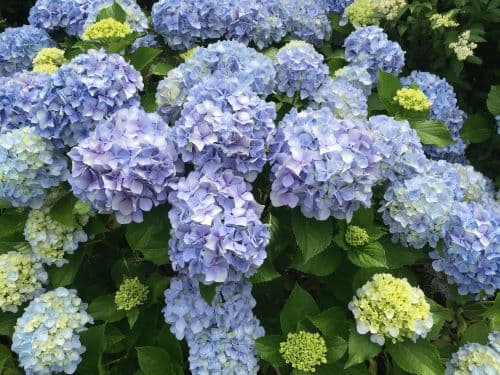
How to Grow Hydrangea Flower Bushes
Hydrangea bushes are easy to grow. They prefer full sun to partial shade. In warmer climates, put them in a more shaded area, to reduce wilting in the midday sun. They prefer moist, rich, loam soil that drains well.
Select a planting location where these big and beautiful bloomers can be seen. And, allow enough space do the shrub can grow to its full potential without looking over-crowded. First, fill the hole about twice the size of the root ball. Next, add generous amounts of rich compost. Plant the root ball even with the ground level. Then, fill the hole with rich soil. Finally, water thoroughly.
Keep the soil moist the entire season to promote lush growth and big blooms. Do not allow the soil to become wet or soggy for extended periods of time.
Add a general-purpose fertilizer in early spring. Also, you can add a high-phosphorous fertilizer prior to the blooming period. it promotes those gorgeous blooms. However, do not give it too much nitrogen, or you will get great foliage at the expense of fewer blooms.
Flowers will begin to bloom in mid-summer. Remove spent blooms. This will promote even more blooms. To grow bigger blooms, thin some of the stems. More on Deadheading blooms.
Apply a thick layer of mulch every spring. This has multiple benefits for the shrub. First, it helps retain soil moisture. It keeps the weeds down. And it provides a neat and tidy appearance. Also, as the mulch decomposes, it replenishes nutrients into the soil for the plants.
The pH level of the soil influences flower color. See below.
No Blooms? The most common cause is winter damage. A frost will kill the buds. Too much shade and poor soil conditions can also result in no blooms.
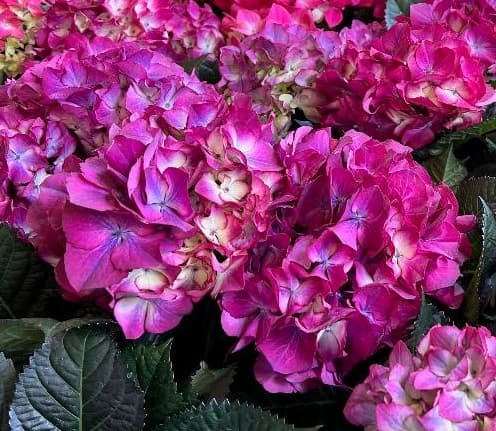
Color Me Hydrangea
They say a leopard can’t change his spots. But, a Hydrangea can change its colors. Some varieties will change flower colors, depending upon the soil condition.
The amount of the micro-nutrient aluminum available for uptake by the plant results in color changes. The pH level influences the ability of the plant to intake and use this micro-nutrient. In acidic soils high in aluminum, the flowers are blue. The higher the acidity(and aluminum), the bluer the flower. Neutral soils with less aluminum are white. Alkaline soils result in pink blooms.
To change flower colors, adjust the pH level as follows:
- For blue flowers, grow the plants in a soil ph range of 4.0 – 5.0.
- To promote pink flowers, adjust the soil ph range to 6.0 – 7.0.
- For white flowers, the soil ph range is 6.5 – 8.0.
How to Grow Hydrangea Flowers in Containers
You will love growing Hydrangea flowers on your patio or deck where you can enjoy their beauty all season long. But, remember, this is a toxic plant. So, keep young children and pets away from the plant.
Like other container plants, they require a little extra attention than when planted in the ground.
- First, purchase smaller growing varieties.
- Next, the selection of a flowerpot is important. Use a container that is 24 inches in diameter or more.
- Use flowerpots or containers with drain holes in the bottom. This allows excess water to drain so the roots will not rot.
- Keep an eye on the moisture level. Check the plants every day or two, especially in extended periods of hot, dry weather. Keep the soil moist, but not wet. It is okay to let the top of the soil begin to dry between watering. When watering the plants, thoroughly wet the soil. Excess water will drain through the hole in the bottom of the flowerpot.
- Nutrients in a flowerpot are limited. So, use fertilizer spikes to feed the plants. Or, apply a light solution of liquid fertilizer every 2 – 4 weeks early in the season.
- Select a sunny or partly sunny location on your deck. The plants do well in light shade, too.
- After a few years, the root system becomes rootbound. Then, repot them into a larger container.
- In colder regions of the country, overwinter them in a garage, shed, or greenhouse.
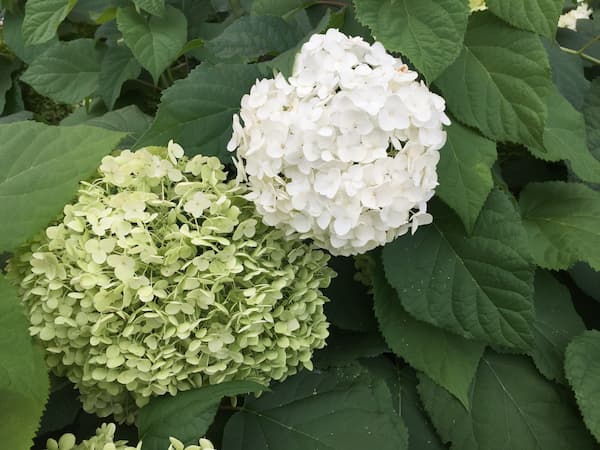
Pruning Hydrangeas Shrubs
During the season, hydrangea shrubs do not need pruning. Of course, you should remove any occasional dead or sickly leaves and stems.
However, you should deadhead the spent blooms. This encourages new buds to form and prolongs the blooming period.
For how to prune plants at the end of the season, see Overwintering Hydrangea Flowers below.
Insects and Plant Disease
Aphids, red spiders and a few other insects can be an occasional problem. Treat with mild insecticides or insecticidal soaps.
Powdery Mildew, blights and leaf spots can occur. Treat plant as needed with a fungicide.
Plant Problems – Identify the causes and find the cures.
Overwintering Hydrangea Flowers
Hydrangea plants need pruning at the end of the season. With over 1,200 species of Hydrangea flowers, it is important to know what type of shrub before you prune them.
For New Wood blooming varieties:
After the first killing frost in the Fall, cut the stems back to the ground. You can also do this in winter or early spring.
For Old Wood blooming varieties:
Do not cut them to the ground. Rather, after five years of growth, it is time to prune them. Prune the stalks back by 1/3 immediately after the flowers have bloomed and died. Next year’s flower buds form quickly on the old wood. If you wait until late August or later to prune them, you will cut off next year’s flower buds. In colder regions of the country, wrap burlap around the plants to keep the buds from being damaged by cold and wind.
Adding a layer of mulch in the Fall is not required. Although you may choose to do so.
Related Articles
Also, people who read this article will like:
Hydrangea Picture Gallery – Free to use, high-resolution hydrangea pictures.
Deer Resistant Flowers – If you’ve got deer, plant flowers the deer do not like.
Please support our site. Shop for:
- rmmatthews100@hotmail.com
- 585-721-6528
- Rochester, NY
©1999-2024 GardenersNet.Com, All Rights Reserved

